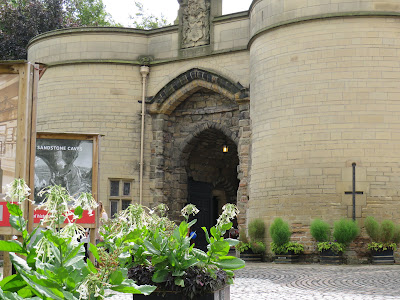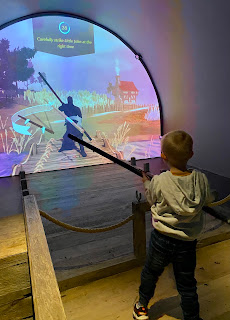Nottingham Castle
Nottingham Castle has over 1000 years of fascinating, often turbulent history with various kings of England -as well as being associated with the legendary Robin Hood and the Sheriff of Nottingham. Since being built by William the Conqueror in 1067, it has had a commanding position on Castle Rock, with 130 foot high cliffs. It has been a Royal residence on several occasions, especially due to its important position in central England overlooking the River Trent. But from the 16th century it fell into decline and was eventually rebuilt as a mansion by the Duke of Newcastle, although this was burnt down by Nottingham rioters in 1831. Once again it was rebuilt, but this time it was as a museum and art gallery.
The first castle would have been Norman, a wooden structure and a motte and bailey design; but in King Henry 2nd's reign, this was replaced by a more defensible stone structure with 3 separate baileys within its walls. Evidence of these moats are still visible in the grounds today.
The Gatehouse is an impressive sight - and if you look down to the left as you approach it, this area was once a grand exercise room for the Dukes' horses - hard to believe now!
The Castle has 6 acres of beautiful gardens, with colourful summer beds, a Victorian bandstand and a dry moat (with a bridge over the top); and of course extensive panoramic views over the city.
This is the Albert Ball memorial - a famous Nottingham War Hero.
On the Upper Lawned area, you will find covered picnic seating and a medieval inspired play area to delight the children - and there are often activities happening on this lawn.
The outside of the building is quite spectacular - even though it is only a mansion house. You just have to remember that various castles have stood on this very spot for 1000 years.
You enter the building itself through a bright modern gift shop - this is where you can book trips to go down Mortimer's hole - the caves under the castle building. Then starting my visit through the various rooms, which you must remember are part of a museum, you will discover over 1000 years of local history. This building was the first public museum/gallery outside of London in Victorian times and is still important now, hosting important exhibitions. Clothing manufacture has long been an important industry in Nottingham as well as the Lace industry; and there are displays of textiles from every corner of the world.
On the Mezzanine floor you will find a whole section dedicated to the Mercian Regiment, soldiers that were local to Nottingham and Derbyshire, and fought in various conflicts from the early 1700's.
I just loved this ...........Private Derby XX1X one of the most recent mascots who passed away in 2013.
As you enter this section, 1500 years of history are brought to life through photographs, displays, stories and models. There is so much to see and to read, as well as to get involved in - especially of you have children with you. As you enter this section, it is describing the horrific events leading up to the Riot in 1831 and the setting fire to the castle by the angry mob who were opposing the Reform Act.
Below is a reconstruction of the town of Nottingham in 1830.
These 3 alabaster's were discovered under the floor of a church in 1779 (they must have been hidden to be protected during the Reformation in 16th century. They were originally painted but have lost their colour over time, these ones in particular because they were stood outside in a garden.
Alabaster carving was a thriving industry in Nottingham as long ago as 15th century, and the figures would have been made from alabaster transported from quarries in Derbyshire and Staffordshire. Nottinghamshire alabaster's are very rare now, as most were lost during the Reformation; as Henry 8th ordered the destruction of superstitious images - this was the end of this industry in Nottingham.
This model is of what the town and castle was supposedly like in the 1500's.
The Domesday Book contains the first mention of Nottingham in 1086. William the Conqueror had a new castle built, at a time when Nottingham was divided into two - Anglo Saxon part and a French part. These 2 settlements remained separate until 1284 when they were united.
These may give you an idea of Nottingham's early history.
And then of course there is the infamous Robin Hood...................
There are interactive areas here where children can dress up, learn about medieval live and take part in numerous activities.
There are so many tales surrounding Robin Hood, and the have been so many films - but to anyone from Nottingham, they are passionate about their Robin Hood. Whilst King Richard 1st of England, also known as Richard the Lion-heart, fought in the Crusades, the supporters of Prince John occupied Nottingham Castle with a view to John becoming the next king. In March 1194 a battle took place at Nottingham and the castle was besieged and surrendered just a few days later........ whether or not someone called Robin Hood actually helped King Richard is something that legends like to tell!
I even spotted a "Lowry" as well as works by local artists.
There were many other types of fine arts on display.
There are more children's play and activity areas as you walk around the ground floor rooms.
I loved this ceramic Giant Pumpkin made by Kate Malone in 2008.
Next I headed outside to see the views from the terraces...............
Then it was time for my tour of Mortimer's Hole - this costs £5.00 and is payable on top of your entrance to the Castle. I chose a day when it was free to get into the Castle - a Heritage day - so it is well worth looking out for those days being put on usually once or twice a year. There are many steps down, over 300, so only go if you feel you can manage.
The castle is perched on the top of a labyrinth of man made caves and secret passageways.
After a talk about the Castle's turbulent 1000 year history, we were taken down into the first passageway of the caves (some of these date back to medieval times when many people lived in them).
It was interesting to see the different colours in the rocks and the sediment from long ago sea-beds.
Graffiti from nearly 200 years ago!
Sir Roger Mortimer and his lover Queen Isabella murdered King Edward 2nd, in order to put her son Edward 3rd on the throne. But after a fateful turn of events, the new monarch turned on his mother and Mortimer, imprisoning him in the Castle before being taken to London where he was executed as a traitor and subsequently hung, drawn and quartered. The tunnel that led to Mortimer's capture is the one that is known as Mortimer's Hole and there are tales of his ghost that haunts the area.
Once I reached the bottom and went outside, we were told more of how different people lived in these cave systems 1000's of years ago - the bricks were cut and placed into the sandstone rocks. This area was once where a baker lived and worked.
A very interesting hour, with a marvellous enthusiastic guide who knew so much of Nottingham's history, she really bought the stories to life - I can highly recommend this trip down to see the caves.
There is a very pleasant cafe with wonderful views, especially on a good day when you can sit on the outside terrace, and a shop selling gifts, books, toys and historical souvenirs. If you have liked a particular painting, they can can create a copy of it of you - that's different and a really good idea.
Over the next few years Nottingham Castle is having millions of pounds invested into it, so that the whole site can be redeveloped into a first class tourist destination - a truly amazing world heritage site. The Mansion house, the grounds, the caves in Castle Rock and Brewhouse Yard are all part of this revitalization plan to reflect the historical importance of this area.
For more information please visit http://www.nottinghamcastle.org.uk/
Thank you,
Lynne
Please check out my other blogs:-






































































































No comments:
Post a Comment